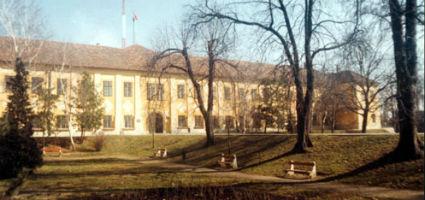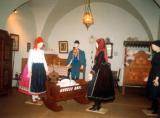2025. July 19. Saturday
Soproni Museum - Museum Collection of Rábaköz - Kapuvár
 |
The Rábaköz Museum obtained the operational permit in 1960, and joined the museological organisation of Győr-Sopron county in 1962. The museum is a regional museum, its target area is the former region of Kapuvár. Items are collected from the fields of archeology, history, ethnography and fine arts.
The "Rábaköz" name refers to Rábaköz-centre, whereas Kapuvár is the centre of the southern part of the Hanság. The collection area is bordered by Osli from the North, Csáfordjánosfa and Rábakecöl from the South, Fertőszéplak from the West, and Szárföld settlement from the East.
At the formation of the museum its main collection consisted of the collection of Sándor Faragó. The collection was first exhibited in the building of the local industry union, later it was moved to the building of the Esterházy mansion.
However, the Rábaköz museum of today owns many kinds of collections.
The archeological collection was first formed on the individual initiative of the above mentioned Sándor Faragó. Although it contains only a certain range of materials, it well represents the excavating sites of Kapuvár region, where recent excavations brought about a considerable amount of new results.
The collection of historical object and documentations are rather versatile. Many kinds of interesting materials can be found here spanning from the 18th century bricks of the former castle to the protection coat of the workers of the local meat processing factory. There are weapons from the two world wars, equippments, flags of fireworks unions, religious documents and objects. The collection illustrates the history of Kapuvár region, and provides the base for further researches.
The most part of the ethnographical collection is made up by the textile collection which contains colourful falk dresses of Kapuvár region, embroyderies, hemps and factory materials. These are supplemented by pieces of furniture, ceramics and religios items.
The fine arts collection consists mostly of random materials obtained by the museum, but the works of local artist are also represented. The local artists are represented by the collections of the plaster and bronze works of sculptor Pál Pátzay Pál andLajos Lukácsy, and the pastel and oil works of painter Imre Ányos.
Besides the religious art items the applied arts collection contains ceramics, furniture, porcelains, glasses, watches and silver items from the 19th and 20th century.
In 1980 the museum purchased a bird collection that represents almost every kind of bird found in Hanság region. The bird collection can be visited on prior notice. Research workers and any visitors can get prompt information about possible visits of the bird collection on the following phone numbers: +36/96/250-334, +36/99/370-919.
A part of the collection of Willibald Nógrádi can also be seen here. In the first half of the 20th century Willibald visited half of the world and collected valueble items into his growing natural collection. As a result of this we can get an interesting range of samples of the Mollusca species of various geographical regions.
Apart from the objects exhibited, documents, a library and a photography collection will help researchers in their studies.
The "Rábaköz" name refers to Rábaköz-centre, whereas Kapuvár is the centre of the southern part of the Hanság. The collection area is bordered by Osli from the North, Csáfordjánosfa and Rábakecöl from the South, Fertőszéplak from the West, and Szárföld settlement from the East.
At the formation of the museum its main collection consisted of the collection of Sándor Faragó. The collection was first exhibited in the building of the local industry union, later it was moved to the building of the Esterházy mansion.
However, the Rábaköz museum of today owns many kinds of collections.
The archeological collection was first formed on the individual initiative of the above mentioned Sándor Faragó. Although it contains only a certain range of materials, it well represents the excavating sites of Kapuvár region, where recent excavations brought about a considerable amount of new results.
The collection of historical object and documentations are rather versatile. Many kinds of interesting materials can be found here spanning from the 18th century bricks of the former castle to the protection coat of the workers of the local meat processing factory. There are weapons from the two world wars, equippments, flags of fireworks unions, religious documents and objects. The collection illustrates the history of Kapuvár region, and provides the base for further researches.
The most part of the ethnographical collection is made up by the textile collection which contains colourful falk dresses of Kapuvár region, embroyderies, hemps and factory materials. These are supplemented by pieces of furniture, ceramics and religios items.
The fine arts collection consists mostly of random materials obtained by the museum, but the works of local artist are also represented. The local artists are represented by the collections of the plaster and bronze works of sculptor Pál Pátzay Pál andLajos Lukácsy, and the pastel and oil works of painter Imre Ányos.
Besides the religious art items the applied arts collection contains ceramics, furniture, porcelains, glasses, watches and silver items from the 19th and 20th century.
In 1980 the museum purchased a bird collection that represents almost every kind of bird found in Hanság region. The bird collection can be visited on prior notice. Research workers and any visitors can get prompt information about possible visits of the bird collection on the following phone numbers: +36/96/250-334, +36/99/370-919.
A part of the collection of Willibald Nógrádi can also be seen here. In the first half of the 20th century Willibald visited half of the world and collected valueble items into his growing natural collection. As a result of this we can get an interesting range of samples of the Mollusca species of various geographical regions.
Apart from the objects exhibited, documents, a library and a photography collection will help researchers in their studies.
